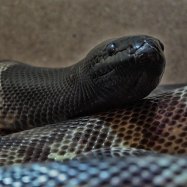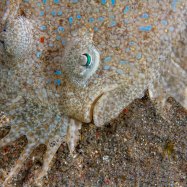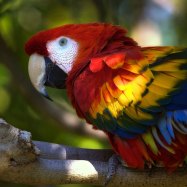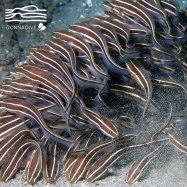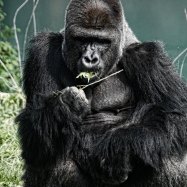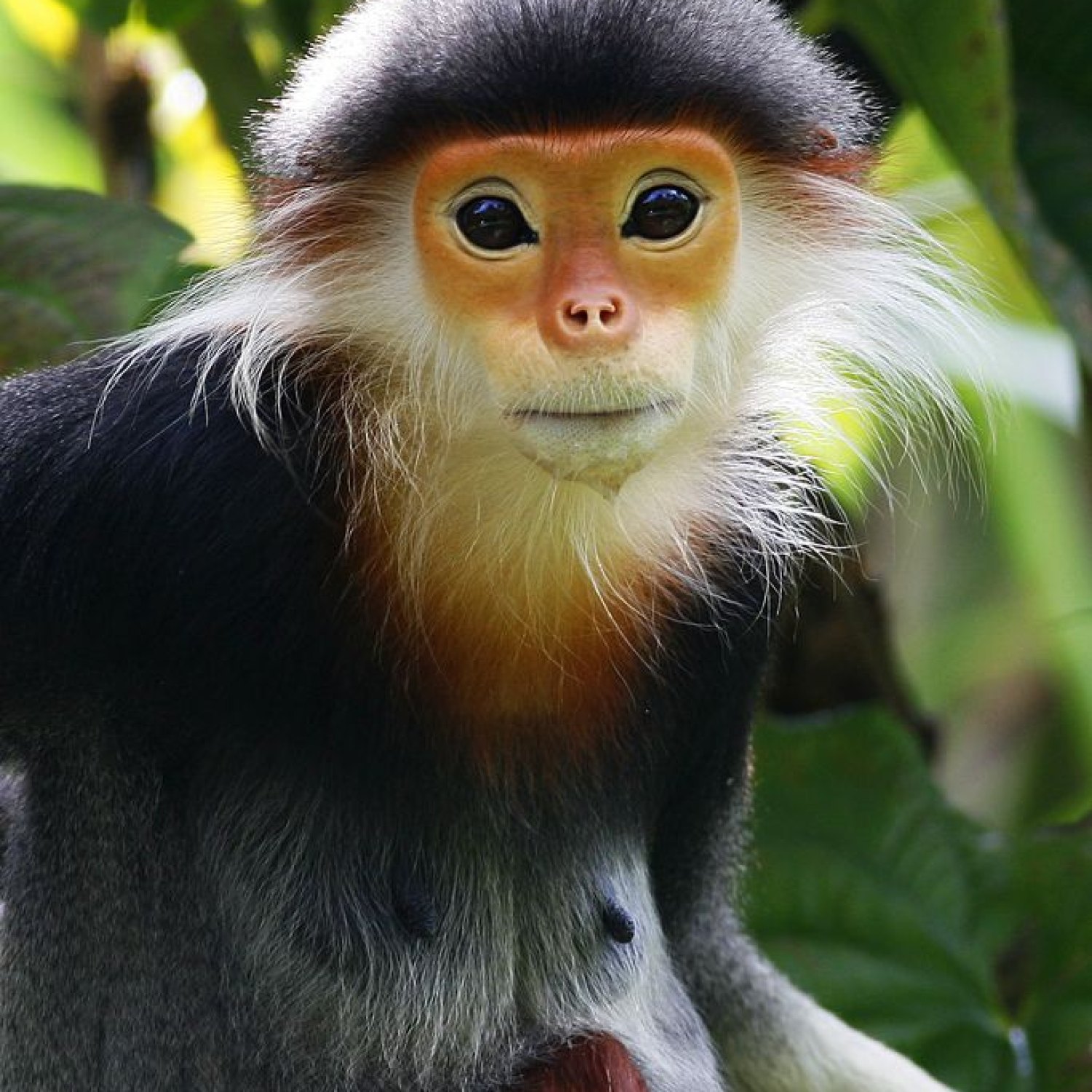
Douc
60 to 75 cm
The Douc is a stunning primate found in the Central Highlands of Vietnam. With its medium-sized and slender body, it measures between 60 to 75 cm in length. Belonging to the Cercopithecidae family, it is commonly known as the Douc Langur. Unfortunately, this beautiful animal is currently facing threats to its survival due to habitat loss and poaching. Let's work together to protect this amazing species for future generations to enjoy. #Douc #Vietnam #primate #conservation
Animal Details Summary:
Common Name: Douc
Kingdom: Animalia
Habitat: Tropical and subtropical rainforests
The Enigmatic Douc: A Rainbow in the Jungle
Nestled in the lush green depths of the Southeast Asian rainforests, a vibrant and elusive creature can be found. With its rainbow-like appearance and enigmatic nature, the Douc, or Pygathrix nemaeus, is a primate that has captured the hearts and minds of many nature lovers. But beyond its colorful fur and slender body, the Douc has many fascinating and unique features that make it stand out among other primates. In this article, we will delve deeper into the world of the Douc and uncover the secrets of this captivating animal Douc.A World of Primate Wonders
The Douc is a member of the animal kingdom, specifically in the phylum Chordata. Like humans, it belongs to the class Mammalia, which means it is a warm-blooded, vertebrate animal that feeds its young with milk. Within the Mammalia class, the Douc falls under the order Primates, which includes other familiar animals such as monkeys, apes, and humans. These animals are known for their advanced cognitive abilities and dexterous hands, making them one of the most diverse and fascinating groups in the animal kingdom.The Douc is a part of the Cercopithecidae family, which comprises Old World monkeys found in Africa and Asia. These monkeys are characterized by their long tails, diverse diets, and a distinctive ear structure. The Douc, in particular, has a unique and colorful fur pattern, making it one of the most visually striking primates in the family.
A Tropical Haven: The Habitat of the Douc
The Douc is native to the tropical and subtropical rainforests of Southeast Asia. Its geographical distribution is concentrated in countries such as Vietnam, Laos, and Cambodia Desert Tortoise. These countries host the majority of the Douc population, with the Central Highlands of Vietnam being a particularly popular location for this primate.Within its natural habitat, the Douc can be found swinging gracefully from tree to tree, using its long limbs to move through the dense foliage effortlessly. Due to its excellent climbing abilities, the Douc is considered a semi-arboreal animal, spending most of its time on trees but occasionally coming down to the ground to forage for food.
A Herbivore's Delight: The Feeding Method of the Douc
The Douc is a herbivorous primate, which means it feeds primarily on plant matter. Its diet consists of a variety of fruits, leaves, flowers, and even the occasional insect or bird egg. As a selective feeder, the Douc carefully chooses its food and is known for its slow and deliberate feeding style.One of the most fascinating aspects of the Douc's feeding behavior is its ability to distinguish ripe fruits from unripe ones. It uses its sharp vision and color perception to identify the most nutritious and delicious fruits, making its food choices all the more interesting.
A Multicolored Masterpiece: The Animal Coloration of the Douc
One of the most captivating features of the Douc is its vibrant and multi-colored fur. Its body is covered in a combination of red, grey, white, black, and yellow hues, making it look like a living rainbow. The Douc's camouflage abilities are exceptional, as its fur blends in perfectly with the colorful foliage of its habitat, making it challenging to spot.But what is the purpose of such a unique and striking coloration? Scientists believe that the Douc's colorful fur serves as a visual signal for communication and individual recognition within a large group. It is also thought to play a role in mate selection, with females preferring males with more vibrant colors.
The Perfect Proportions: Body Shape, Length, and Weight
The Douc has a medium-sized and slender body, with an average length of 60 to 75 cm. Its weight ranges from 5 to 10 kg, depending on its age and sex. The male Douc is slightly larger than the female, and both genders have a long and bushy tail that they use for balance while moving through the trees.The Douc's body proportions are ideal for its arboreal lifestyle, allowing it to jump and climb with ease. Its elongated limbs and tail provide excellent range of motion, making it an agile and graceful primate.
Conservation Concerns: Threats to the Douc Population
Despite its colorful appearance and fascinating characteristics, the Douc population is facing significant threats in its natural habitat. The destruction of rainforests due to deforestation, poaching for the illegal pet trade, and hunting for food have all contributed to the decline of the Douc population.The International Union for Conservation of Nature (IUCN) has listed the Douc as an endangered species, with a decreasing population trend. Efforts are being made to protect and conserve the Douc and its habitat, with organizations working closely with local communities to promote sustainable and eco-friendly practices.
An Enchanting Experience: Observing the Douc in the Wild
If you ever get the chance to visit the tropical rainforests of Southeast Asia, keep an eye out for these elusive yet enchanting creatures. Seeing a Douc in its natural habitat is a rare and unforgettable experience. However, it is essential to remember to respect the Douc's natural habitat and not disrupt its way of life.It is also crucial to be mindful of the impact of human activities on the Douc population and support conservation efforts in any way possible. With proper conservation measures in place, we can ensure that these beautiful and unique primates continue to thrive in their natural habitat for generations to come.
A True Wonder of Nature
In conclusion, the Douc is a marvel of nature, with its colorful fur, incredible climbing abilities, and unique characteristics. Its presence in the lush rainforests of Southeast Asia adds another layer of beauty to an already stunning ecosystem. As we continue to learn more about this enigmatic animal, let us strive to protect and preserve its natural habitat for future generations to enjoy. The Douc is, truly, a rainbow of the jungle – a symbol of the wonders and mysteries of the natural world.

Douc
Animal Details Douc - Scientific Name: Pygathrix nemaeus
- Category: Animals D
- Scientific Name: Pygathrix nemaeus
- Common Name: Douc
- Kingdom: Animalia
- Phylum: Chordata
- Class: Mammalia
- Order: Primates
- Family: Cercopithecidae
- Habitat: Tropical and subtropical rainforests
- Feeding Method: Herbivorous
- Geographical Distribution: Southeast Asia
- Country of Origin: Vietnam, Laos, Cambodia
- Location: Central Highlands of Vietnam
- Animal Coloration: Vibrant and multi-colored fur
- Body Shape: Medium-sized and slender
- Length: 60 to 75 cm

Douc
- Adult Size: 5 to 9 kg
- Average Lifespan: 25 to 30 years
- Reproduction: Sexual
- Reproductive Behavior: Mating occurs throughout the year
- Sound or Call: Loud and distinct vocalizations
- Migration Pattern: Non-migratory
- Social Groups: Large groups of up to 50 individuals
- Behavior: Active during the day, agile climbers
- Threats: Habitat loss, hunting, and poaching
- Conservation Status: Endangered
- Impact on Ecosystem: Seed dispersers
- Human Use: Hunted and traded for its fur and body parts
- Distinctive Features: Brightly colored face and fur, long tail, and tufted ears
- Interesting Facts: Doucs are highly arboreal and spend most of their time in trees
- Predator: Mainly hunted by humans
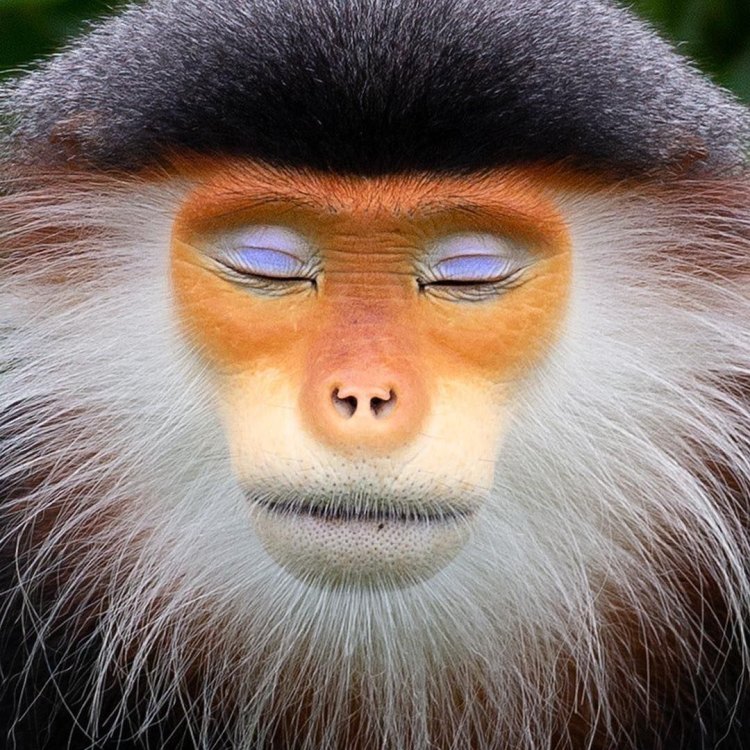
Pygathrix nemaeus
The Fascinating World of Douc Monkeys
The world is full of fascinating and unique creatures, and one of them is the douc monkey. This primate species, also known as Pygathrix, is native to Southeast Asia, particularly in countries such as Vietnam, Laos, and Cambodia. Named after the French word for "tufted," these monkeys have distinctive features that make them stand out among other primates. In this article, we will delve into the extraordinary world of douc monkeys and discover what makes them so unique PeaceOfAnimals.Com.A Unique Appearance
One cannot help but be captivated by the striking appearance of douc monkeys. These medium-sized primates have a distinctive appearance, with a splash of bright and vibrant colors. One look at a douc, and you'll understand why it is often referred to as the "costumed ape." They have a brightly colored face, ranging from shades of blue, red, white, and black, making them one of the most colorful primates in the world.Their colorful fur is also a sight to behold, with shades of gray, black, and white, organized in bands to form a unique pattern. The bright colors and patterns on their face and fur are sexually dimorphic, meaning that they are more vibrant in males, making them even more attractive to the opposite sex.
In addition to their colorful features, doucs also have a long, slender tail, which can reach up to twice the length of their body. They also have tufted ears, adding to their already unique appearance.
An Arboreal Lifestyle
One of the most distinctive features of douc monkeys is their arboreal lifestyle Dunkleosteus. These primates spend a majority of their time in trees, and their bodies are well-adapted for this lifestyle. They have long, nimble fingers and toes, enabling them to grasp on to branches and move around effortlessly in the trees.Doucs are also agile climbers and can jump up to 20 feet from branch to branch. This ability allows them to move swiftly and efficiently through the dense forest canopies. They are also excellent brachiators, which means they can swing from branch to branch using their arms.
Social and Reproductive Behavior
Doucs are highly social animals and live in large groups consisting of up to 50 individuals. These groups are often made up of several males and females, although there is a hierarchy within each troop. The dominant male leads the group, and the rest of the females and males follow.Mating in doucs can occur throughout the year, and it is not limited to a specific season. The dominant male has mating privileges, and he will mate with the females in his group multiple times to ensure successful reproduction. After a gestation period of around 170 days, the female will give birth to a single offspring.
The Seed Dispersers of the Forest
Beyond their striking appearance and social behaviors, douc monkeys play a crucial role in the ecosystem. They are known as seed dispersers, meaning they help in the dispersion of fruits and seeds throughout the forest. As they move around and feed on fruits and seeds, they spread the seeds through their feces, allowing new plants to grow in different areas.This important role of seed dispersers helps in the regeneration and growth of the forest, making douc monkeys an essential part of the ecosystem.
The Threats Faced by Douc Monkeys
Sadly, despite their critical role in the ecosystem, douc monkeys are facing several threats, both from natural causes and the actions of humans. The destruction of their habitat is one of the most significant threats faced by this species. Deforestation and habitat loss due to agriculture, logging, and urbanization have significantly reduced their numbers in the wild.Moreover, doucs are also hunted and poached for various reasons. They are hunted for their meat, which is considered a delicacy in some cultures, and their body parts are also illegally traded for medicinal purposes or as souvenirs.
An Endangered Species
Due to these threats, douc monkeys have been classified as endangered by the International Union for Conservation of Nature (IUCN). Their population is declining, and it is estimated that there are only around 5,000 to 10,000 individuals left in the wild.To protect and conserve this unique and vital species, several conservation efforts have been put in place. This includes the establishment of protected areas, such as national parks and wildlife sanctuaries, where doucs can live without the fear of human disturbance. There have also been efforts to raise awareness about the threats faced by doucs and the importance of conservation.
The Human Use of Douc Monkeys
Unfortunately, douc monkeys have also been exploited by humans for their own gain. They are often hunted and traded for their fur and body parts, and this has had a significant impact on their declining population.Hunting and trading of douc monkeys have been outlawed in many countries, but it still continues illegally in some regions. Such actions not only harm the species, but they also disrupt the delicate balance of the ecosystem, affecting other plants and animals that rely on doucs for their survival.
Final Thoughts
In conclusion, douc monkeys are a unique, fascinating, and important species. Their distinctive appearance, arboreal lifestyle, and critical role in the ecosystem make them an integral part of the natural world. However, they face numerous threats, and their population is rapidly declining, making it crucial for us to take action and protect these incredible creatures for future generations.As we continue to learn and understand more about douc monkeys, we must also remember our responsibility to protect and conserve them. Let us work together to ensure that these magnificent creatures continue to thrive in the wild and inspire us with their vibrancy and resilience.
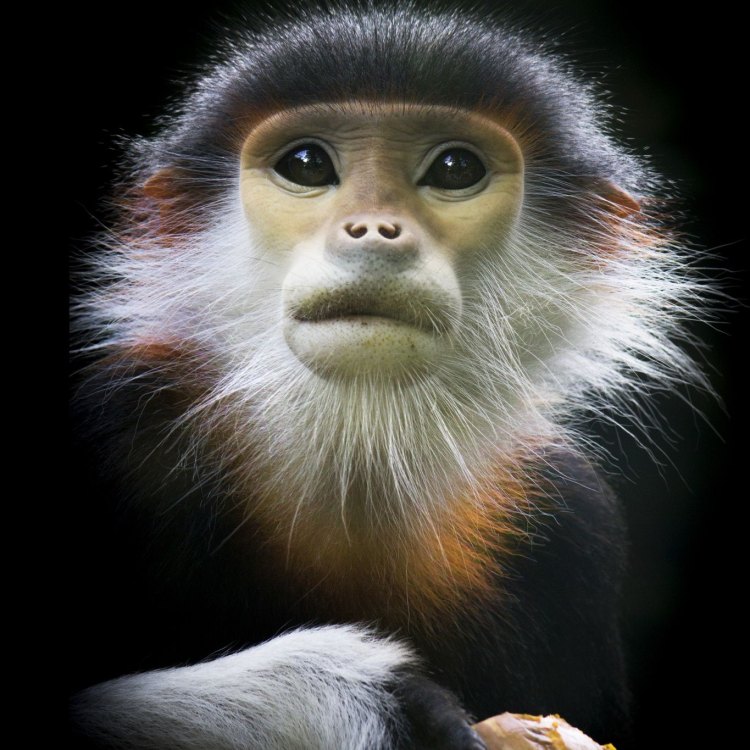
The Enigmatic Douc: A Rainbow in the Jungle
Disclaimer: The content provided is for informational purposes only. We cannot guarantee the accuracy of the information on this page 100%. All information provided here may change without prior notice.

